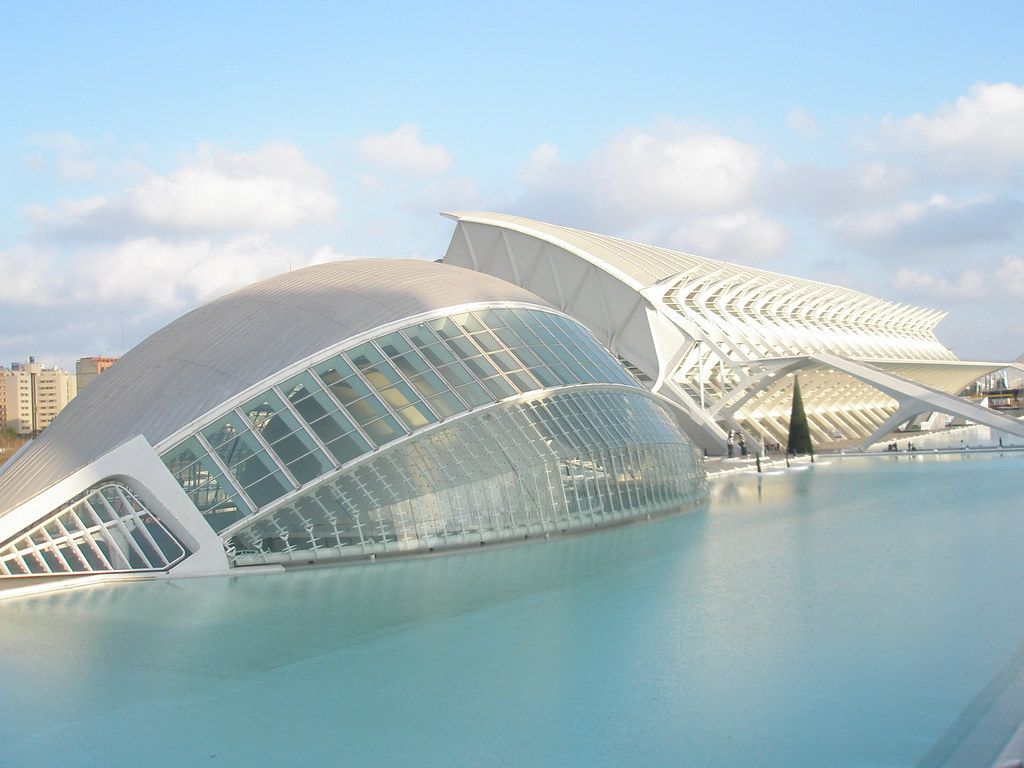
Valencia is a city that has been considered by many to be one of the best cities to live in, so imagine what it’s like to visit and enjoy all its charms… Located in the eastern part of Spain, it is one of the most populated cities in the country along with Madrid and Barcelona, as well as an international attraction for tourists and travellers from all over the world.
As well as standing out for its quality of life, you will find a good selection of places to visit. Both in the historic centre and in the part of the Turia Gardens that run through much of the city, housing large green spaces, parks, the City of Arts and Sciences and much more.
Content
The best way to see and visit Valencia: taking a free tour
If this is your first visit to the city, one of the best alternatives is to take a free tour of Valencia. You’ll discover the best of Valencian culture and history with a local guide as you take in the main points of interest.
If you haven’t been lucky enough to experience a free guided tour, we recommend you take a look at the concept of free tours. In addition, these are all the cities where you can find free walking tours around the world.
Have you tried free tours? Visit the city in a different way with an official local guide.
GuruWalk
What to see in Valencia in 3 days (a weekend)?
Valencia is famous for the City of Arts and Sciences with its futuristic structures such as the Oceanographic, or Hemispheric, and even its Bioparc. In addition, in its streets you can enjoy baroque and modernist architecture, as well as very close to the city, you can visit spectacular natural areas, such as its beaches or the famous Albufera.
Valencia is currently recognised by UNESCO for its incalculable historical and cultural value thanks to the civilisations that have passed through this beautiful city. This legacy, which UNESCO recognises, includes three of the most representative assets: La Lonja de la Seda, Las Fallas and the Tribunal de las Aguas.
1. Plaza de la Virgen
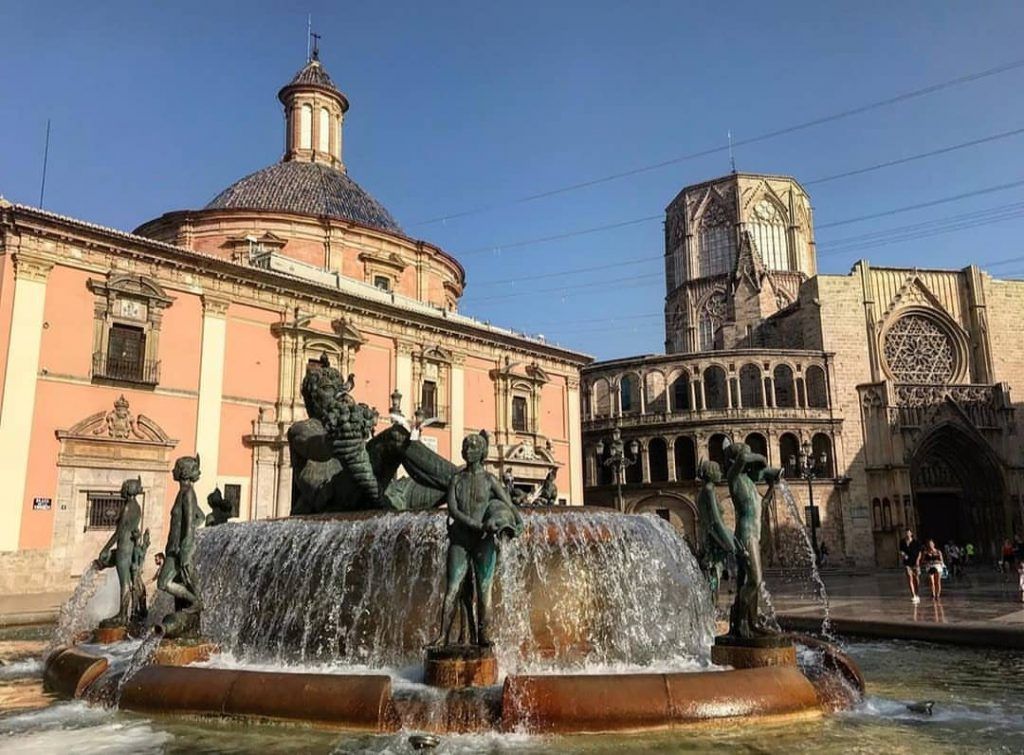
In the Plaza de la Virgen the construction of the city of Valencia began, it is located in the historic centre of the city where the Cathedral of Santa Maria, the fountain representing the river Turia, the Palace of the Generalitat Valenciana (similar to a castle) and the Basilica of the Virgen de los Desamparados are located. It’s a beautiful array full of history, magic and reality.
The best time to visit Valencia is in spring, the temperature is ideal, the buildings are illuminated at night and the gardens are exceptionally colourful. However, it is also worth going to Las Fallas in March.
A large number of tourists pass through the Plaza de la Virgen every day. And many of them are looking for a nice terrace with a good view to have a drink and talk about the mythical history of the square. When the sun goes down, many young people ride their skateboards, roller skates and bikes to practice their manoeuvres in this area of the historic centre of Valencia.
The Plaza de la Virgen has its origins in Roman times, the main point of two great roads of the Roman city, El Cardo (currently Calle de San Vicente Mártir) and El Decumano (currently Calle de Caballeros). In addition, the square is the site of important events worth mentioning:
Weekly meetings of the Tribunal de las Aguas in front of the door of the Apostles of the Cathedral. This Tribunal usually meets every Thursday to settle disputes between those in charge of irrigating the fields of the Vega de Valencia over the use of water from the canals.
The Offering of Flowers to the Virgen de los Desamparados which takes place every year during the Fallas. Inside the Plaza a huge image of the Virgin with the Child Jesus is installed and her mantle is made with the flowers carried by the falleros of all the fallera commissions who parade in front of the huge monument on the evening of the 17th and 18th of March every year.
Year after year the exhibition of the “rocas”, or floats, take part in the Corpus Christi procession. Every season at this time, the rocks leave the Casa de las Rocas where they are kept for the whole year to be displayed days before the procession in the Plaza de la Virgen.
In this lively square in the old town you will see people from all over the country and the world passing by and taking pictures of some of Valencia’s most symbolic buildings.
Valencia Cathedral
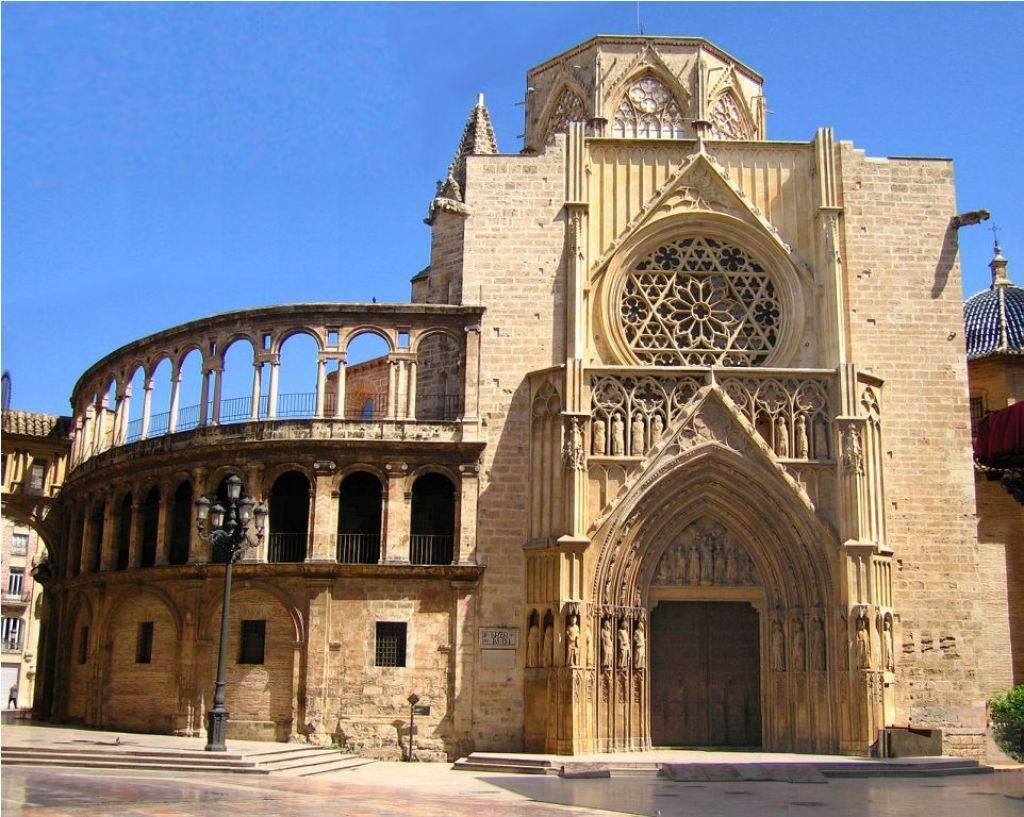
The mother church of the Christian community in Valencia is the Cathedral. This building is dedicated to the worship of God the Father. It houses all Catholic believers of good will. The Cathedral has witnessed the passing of time, the history of mankind, archives, images, religious culture of the Valencian Christian people from the 4th century to the present day.
Inside the Cathedral there are many interesting things to see. The Holy Chalice can be found in the Cathedral of Valencia, as well as important pictorial works of the Spanish Renaissance, works by Maella, Goya and many more renowned painters. Learn about the history of the Virgen del Buen Parto or take a walk on the heights of the Miguelete are curiosities worth seeing and enjoying in Valencia.
The cathedral is predominantly Gothic in style but it preserves various elements from different periods. Previously the Cathedral was a mosque, however, in addition to the Gothic style it preserves elements from other periods such as Romanesque and Baroque. This Cathedral is dedicated to the Assumption of St. Mary, blending art and history. Its walls protect the Holy Chalice, the documents and the archaeological studies with which it is suspected that the Grail of Valencia is the one used by Jesus at the Last Supper. Inside you can appreciate the Renaissance frescoes of the Cathedral’s High Altar by the artists Paolo de San Leocadio and Francesco Pagano.
In the Cathedral there is the Cathedral Museum with about 90 works of different styles, Renaissance, Mannerist, Gothic. The canvases by Maella and Goya and the panel paintings by Juan de Juanes stand out. Climbing the Miguelete is quite a challenge with its 207 steps, but it is also a must for the panoramic views that can be seen from the top.
Basilica of the Virgen de los Desamparados
In the Plaza de la Virgen is the Basilica of the image of the Virgen de los Desamparados next to the Cathedral. There is La Peregrina which is another image of the Virgen de los Desamparados. La Peregrina travels through different neighbourhoods, entities or associations in Valencia. The Virgin of the Forsaken is called the “geperudeta” (cheperudeta or jorobadita).
The Virgin of the Forsaken is linked to the birth of the first hospital for the insane in the world known as the “Hospital de Ignoscents, Folls e Orats”, the hospital was placed under the foundation of the Virgin Mary. With the passing of time the image took the name of “Nostra Dona Sancta Maria dels Ignocents” and from 1493 the decision was taken that the image would be called “Nostra Dona Sancta Maria dels Ignocents”.
The Virgin is standing, with her back curved and her face downwards. In her right hand she holds a bouquet of lilies and a rose as symbols of purity. In her left hand the infant Jesus is carried. In 1885 she was proclaimed Patron Saint of the City of Valencia. In 1954 she was named honorary and perpetual Mayoress of Valencia and in 1961 she was named first and foremost Patron Saint of the entire Valencian Region (now the Autonomous Community).
Undoubtedly, one of the essential places to see and visit in Valencia for everything there is to see in this Plaza de la Virgen, with special attention to the Basilica of the Virgen de los Desamparados.
2. Plaza del Ayuntamiento
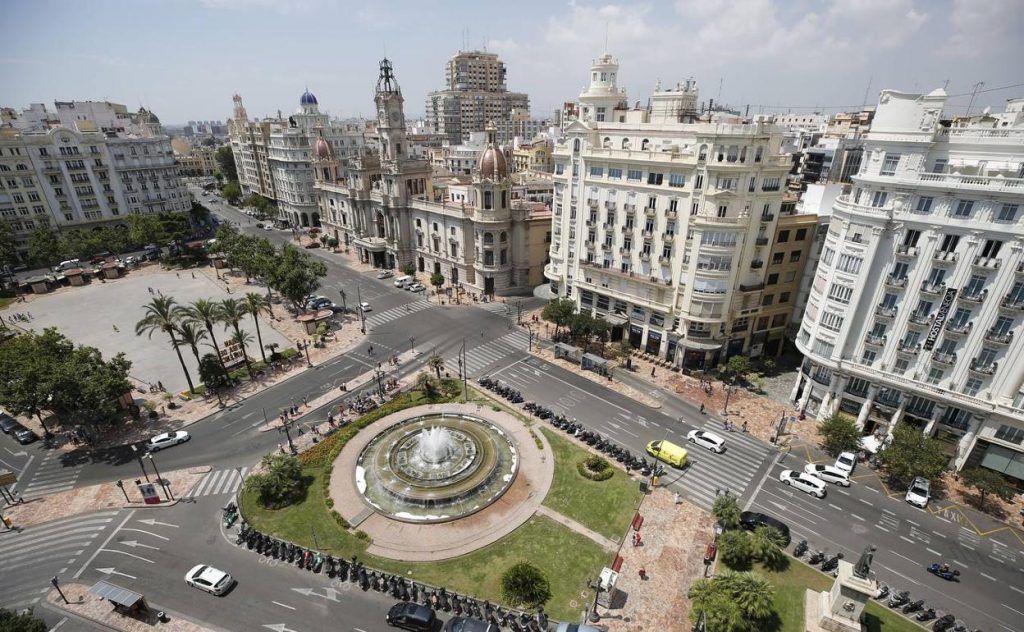
Another important site in Valencia is the Plaza del Ayuntamiento, formerly known as Plaza del Caudillo. It is less than 5 minutes from the Plaza de la Virgen. The first thing you see is the white façade of the Casa Consistorial. The Casa Consistorial was built between 1758 and 1763 in a mixture of neoclassical, neo-baroque and neo-renaissance styles. In the centre of this square is a circular fountain and many flower stalls.
Opposite the Town Hall is the emblematic Correos y Telégrafos building resisting the day of mascletà with its loud explosions for the Fallas celebrations. Free walking tours, such as GuruWalk, often pass through this important and imposing square.
The origin of the Plaza del Ayuntamiento in Valencia lies in the large plot of land that was created by the demolition of the Convent of San Francisco in 1891. A large park was to be built on the empty space, and although trees, hedges and gardens were planted, the project did not succeed. And the old place known as the Park of San Francisco is nowadays the space for events organised by the city of Valencia.
The Plaza del Ayuntamiento is the ground zero of Valencia. In this area you can find theatres, leisure and drinks to enjoy during your stay in this beautiful city. The Town Hall occupies a block of just over 6 thousand square metres, with a façade on the 4 streets on which it is located. The main façade has the Clock Tower and the Main Balcony. The rear façade, which is on Arzobispo Mayoral street, is full of windows with grilles and balconies, and to the right is the façade of the old school church.
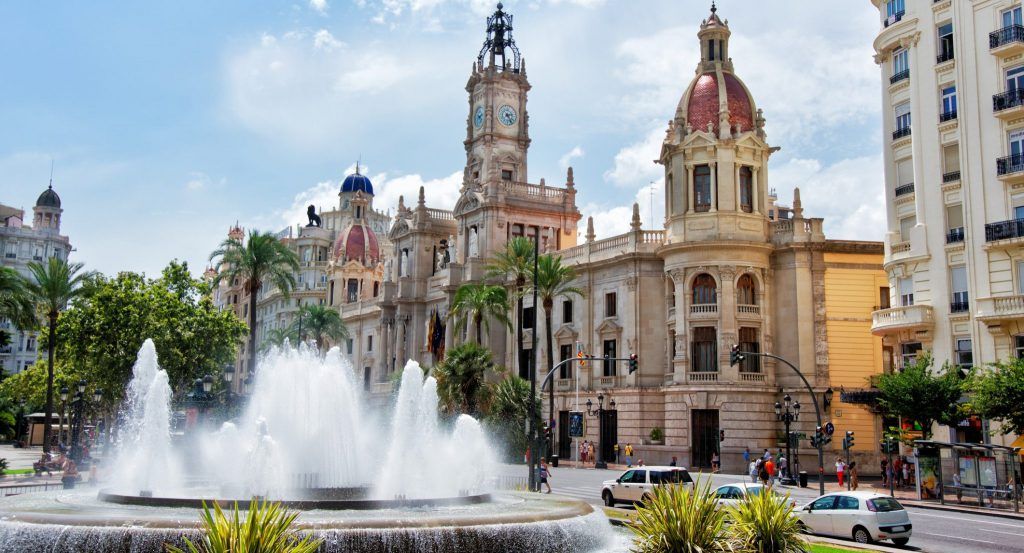
The façade on Calle Periodista Azzati has an entrance that gives access to municipal buildings in use. The Town Hall Square hosts the event of Las Fallas from the 1st of March until the end of the Fallas festival on the 19th of March. This square is filled with gunpowder and people at this time every day at 14:00 hrs.
Valencia’s Plaza del Ayuntamiento is also famous for its fountain, which is illuminated at night and the light changes colour. Its varied flower stalls are the special and different icons of the square. Valencia is really enjoyable on foot, so you can undoubtedly appreciate the main monuments that are within walking distance of each other.
3. Lonja de la Seda
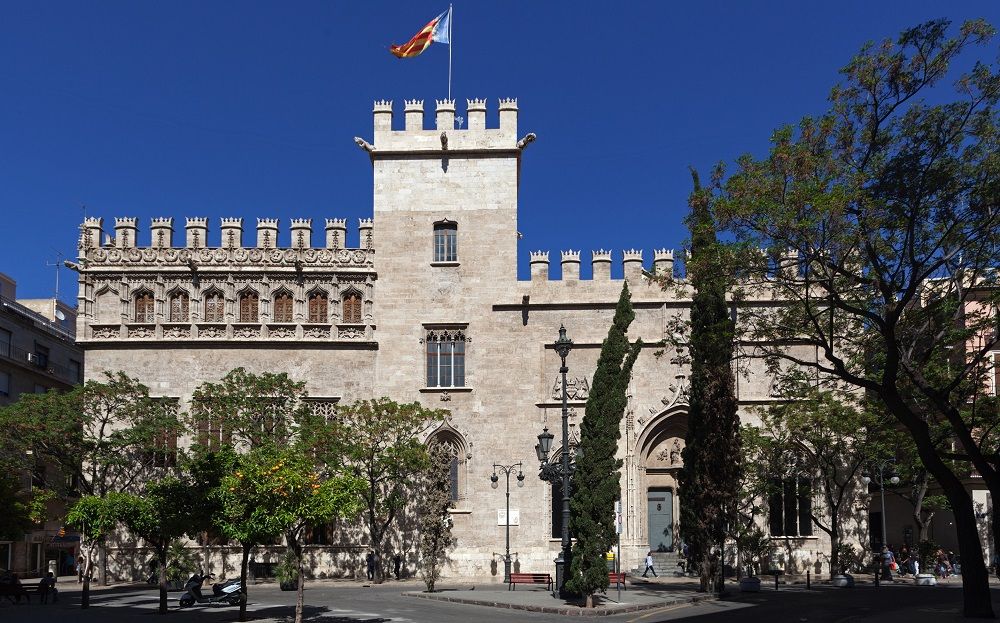
The Lonja de la Seda de Valencia, also known as the Lonja de los Mercaderes, is a civil Gothic masterpiece located in the historic centre of the city of Valencia. It is a characteristic building of the city and is one of the most famous monuments that Europe has to offer. It has been listed as a Historic-Artistic Monument since 1931. It was declared a World Heritage Site by UNESCO in December 1996.
The Lonja de Mercaderes is located right in the centre of the city, opposite the Central Market and the Temple of the Santos Juanes. It occupies an area of about 1990 square metres on a rectangular surface. Previously, the old Lonja was insufficient to cope with the prosperity of the city at the end of the 13th century, and in 1492 the foundation stone of the new Lonja was laid, and construction began one year later.
The Lonja consists of three sections and an orange tree courtyard. The trading hall is divided into 5 transversal naves and 3 longitudinal naves. It has a height of 17.40 m. Some time later UNESCO integrated Valencia into the Silk Route, which passes through 32 cities in Europe and Asia.
The economic power of Valencia in the 15th century is shown with La Lonja in the Golden Century. Passing through the courtyard you enter the interior of the building, in the Contracting Hall, where the Valencian textile trade deals of the time were concluded.
4. The Central Market
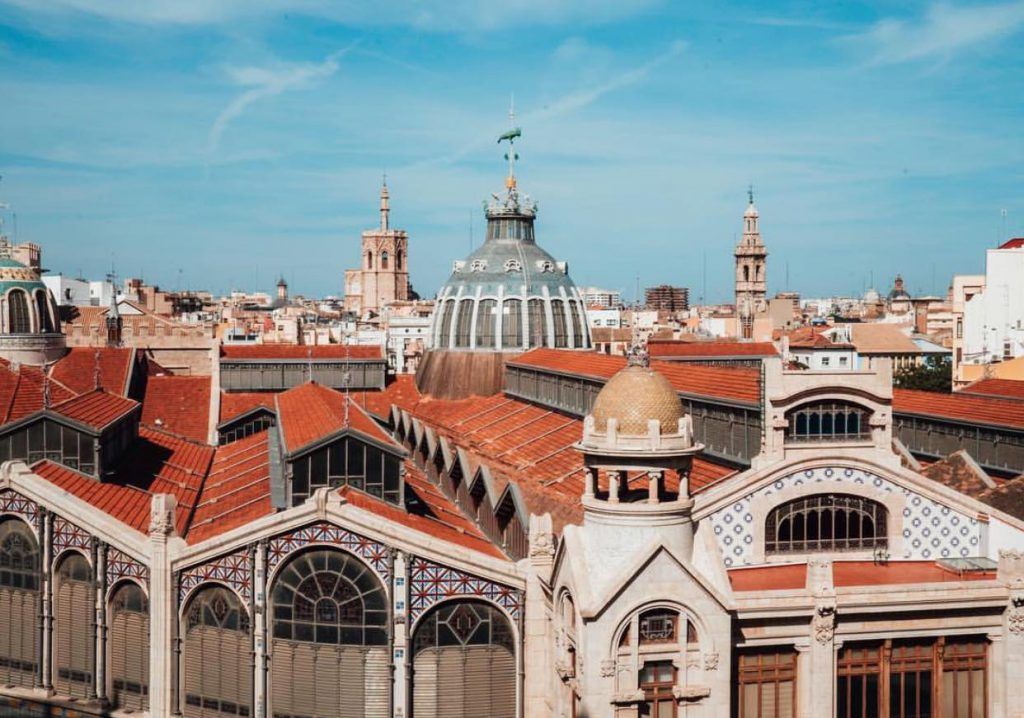
The Central Market is located in the Plaza de la Ciudad de las Brujas, right next to the Lonja de la Seda. This peculiar market, built in 1914, is one of the masterpieces of Valencian modernism. It was built by two renowned architects from the Barcelona School of Architecture, Alexandre Soler i March and Francesc Guàrdia i Vial. However, in 1928, the Valencian architect Enrique Viedma Vidal took over the direction of the project and brought it to an end. The architecture of the Central Market should not be missed, nor should its domes, stained glass windows, columns and every touch of Gothic and Modernist style.
The market was renovated in 2004, and this comprehensive refurbishment brought both its market functions and its structure up to date. Today you can find around 1,200 stalls offering all kinds of food products such as meat, fish, seafood, fruit, vegetables, and much more. The market supplies prestigious Valencian restaurants, as it is known for its fresh produce.
5. The Serranos Towers
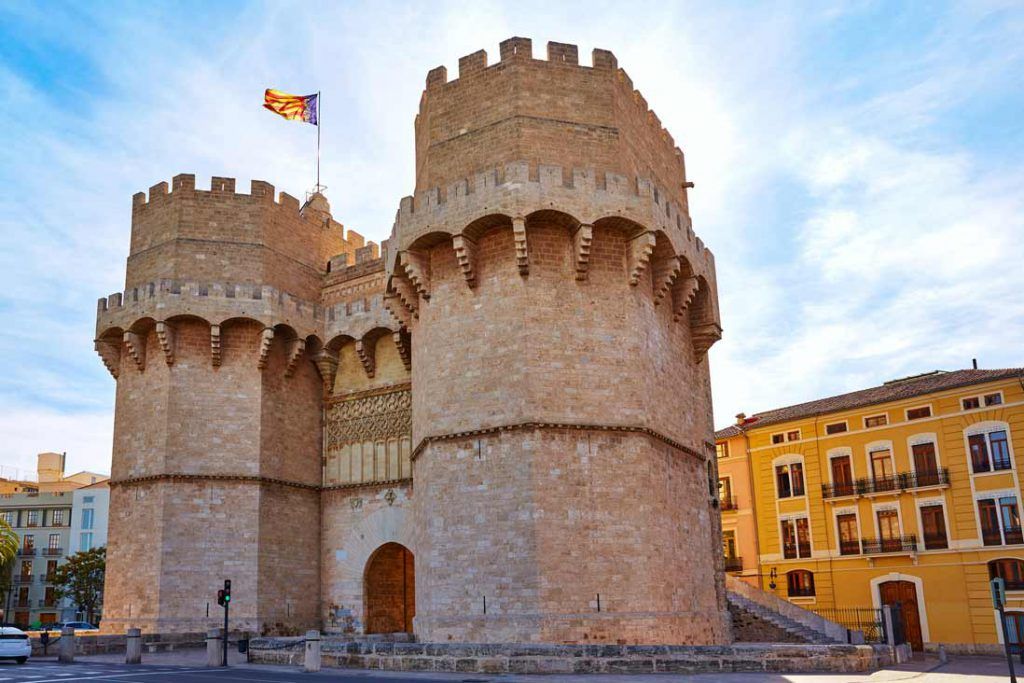
The Serranos Towers date back to 1392. They were built by Pedro Balaguer to defend one of the entrances to the old city. At that time, 95% of the people entering the city passed through here, and perhaps from that time onwards they became so important in the Valencian city. It is even said that a toll had to be paid every time someone entered or left. In 1865 the walls that formed part of the towers were demolished and only the towers were left standing.
From the mid-16th century until the end of the 19th century, the towers were used as a prison, where nobles who committed misdeeds were sent to prison. It is one of the best examples of military architecture of that period on the Iberian Peninsula. For this reason, its characteristic Gothic style should not be overlooked. As well as the back of the Towers, which has five rooms decorated with ribbed vaults and pointed arches. In addition, some gargoyles can be seen on the interior façade. Although these date back to the 20th century.
In 1931 the Serranos Towers were declared a National Historic and Artistic Monument. The origin of the name “Serranos” is curious, it comes from a geographical location. This can be clearly seen if we analyse where the gate is located. It is located on the north side of the city. It is therefore the gateway through which the people from the Serranía area, also known as “los Serranos”, used to enter the town. The bridge just in front of the towers also has the same name: Puente de los Serranos (Bridge of the Serranos). The architect Pedro Balaguer, builder of the towers, was also involved in the construction of Valencia Cathedral and the Miguelete.
During the Spanish Civil War, the towers served as a refuge for some of the works of the Prado Museum in Madrid. In order to protect them, a concrete vault had to be built on the first floor with an important humidity and temperature control.
Nowadays the Serranos Towers, as well as being an essential part of any tourist’s visit to the city, is an important place when some of the city’s most important celebrations take place. There, the Crida is held on the last Sunday in February, by the Fallera Mayor of Valencia. It is the moment when she welcomes the whole city to inaugurate the Fallas, an event that is well worth witnessing.
6. Mercado de Colón
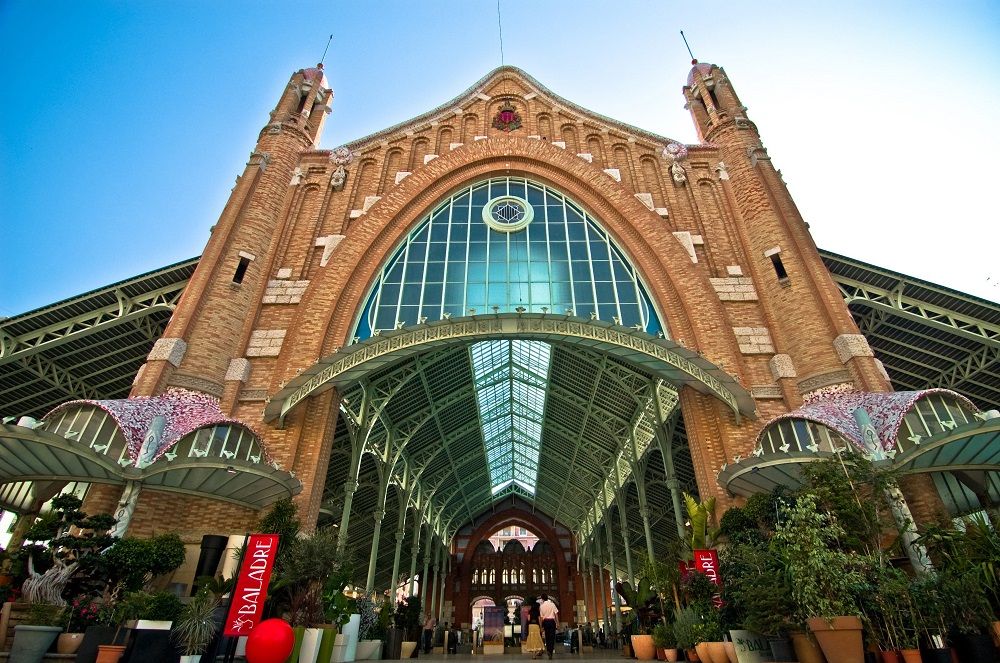
The Mercado de Colón used to be a regular market. Today it houses various flower stalls and the best restaurants. It is one of the most beautiful buildings in Valencia. The Colón market was designed by the architect Francisco Mora Berenguer at the beginning of the 20th century. It is one of the most representative works of Valencian modernism. It was even declared a National Monument. Moreover, its design is reminiscent in some of its peculiarities of Gaudí’s constructions in Barcelona.
It is a 3,500 square metre building divided into three naves, the ends of which are closed by two stone and brick gates in the form of triumphal arches. Its façade contains colourful ornamentation, ceramic details typical of the area and an artistic wrought iron grille that surrounds the building. The building has been meticulously restored, as have the entrances and its height. All this makes this market an open and luminous space.
The fitting-out project was created in an elegant and sensitive setting where the monument can be appreciated in a modern, comfortable and avant-garde environment. This contemporary project has served as an elegant contrast to the historic building, leaving the monument’s prominence intact. It is now a wonderful space in which to relax, see and hear the appeal of the city centre. The refurbishment focuses on the 6 glass cubes with good interior backlighting and a beautiful water cascade.
The building was built to meet the needs of the wealthy class of the time. It is still located in one of the most affluent areas of Valencia, the Ensanche, which receives many visitors every day.
What to do in the Mercado de Colón?
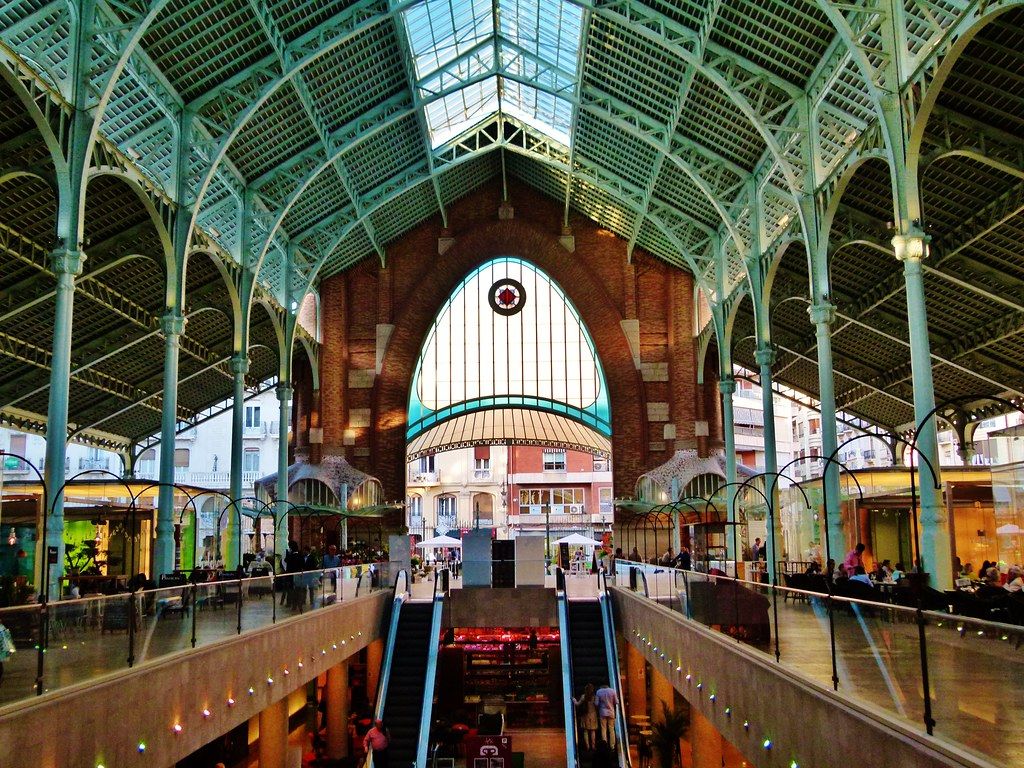
Nowadays, the Mercado de Colón has several renowned shops such as Carnes Varea, or Frutería Fina. However, its main strength is its restaurants. These include Habitual by Ricard Camarena, Ma Khin Café, Manglano, among many others. Although we can also find Las Cervezas del Mercado, Daniel’s horchata stall, the cafeteria Bocados.
As well as Balade flower shop, which was the first to be installed in the courtyard, where it now shares space with Vinos y Flores. In addition, a large number of events normally related to gastronomy are held within the premises.
7. Turia River Gardens
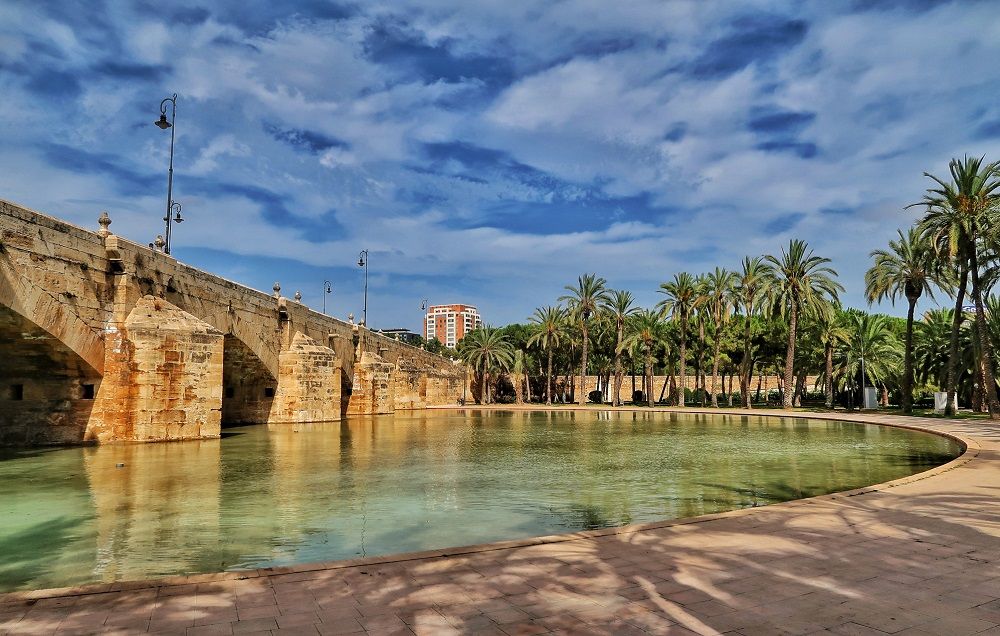
The Turia River Gardens are located in what used to be its riverbed. It used to run through the city, but it was diverted to make a space for fun and sport. It is one of the largest green areas in the city. The Jardines de Turia are catalogued as the largest expanse of gardens that exist for a family stroll.
The huge garden is bounded to the west by the Parque de Cabecera, the Bioparc and the famous City of Arts and Sciences on the opposite side, almost at the exit. The Turia Gardens can be said to link the African savannah recreated with precision in the Bioparc, with the underwater world and ecosystems that can be visited in the Oceonográfic and with the opera auditorium, the Palau de las Artes, both in the City of Arts and Sciences.
Along the route there are other stops of interest such as Gulliver, the huge slide park, where children in particular can slide, climb and have fun on the legs, fingers or hair of this giant 70-metre figure, as if they were real inhabitants of Lilliput. Not far from the park is the Palau de la Música, which offers a full programme every year and very large esplanades outside, ideal for children to play football or skate and show off their skills.
Small boats in the shape of swans can be rented in the ponds surrounding the City of Arts and Sciences. In the summer months there are canoes and balls to ride on the water. As Valencia is a flat city, the Turia Gardens are ideal for jogging or walking, as well as for cycling, tandem or segway tours of the gardens. These vehicles can be hired on site.
In the area there are very nice cafés and bars with large terraces for relaxing. The Turia Gardens have 18 bridges from different periods and architectural styles.
8. City of Arts and Sciences
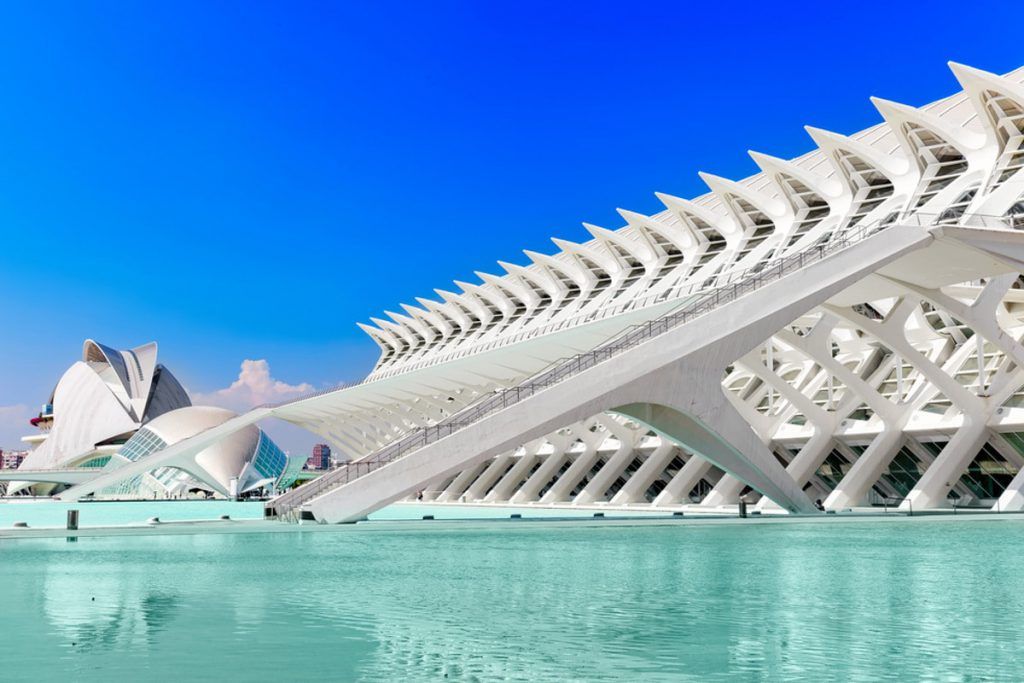
The City of Arts and Sciences was inaugurated in 1998, the design looked like something out of a film from the future. Today, however, it is one of the most important identities of the city of Valencia. Santiago Calatrava’s architecture as an architect, civil engineer and sculptor, intertwines ingenuity, creativity and art in the creation of this Valencian icon.
The seven monumental buildings that make up the City of Arts and Sciences are: L’Hemisfèric, the Príncipe Felipe Science Museum, L’Umbracle, the Oceanográfic, the Palau de les Arts, the Ágora and the L’Assut d’or Bridge are the modernist art of Santiago Calatrava brought to a spectacular reality, which can be enjoyed both inside and out. The events and exhibitions that make it up give you the chance to see a brilliant spectacle up close, you can watch a film, an opera, there is an interactive museum and it contains the largest aquarium in Europe.
The City of Arts and Sciences in Valencia is a modern spectacle for visitors. The buildings that compose it offer an avant-garde image that takes us by the hand into the 21st century.
Museum of Sciences
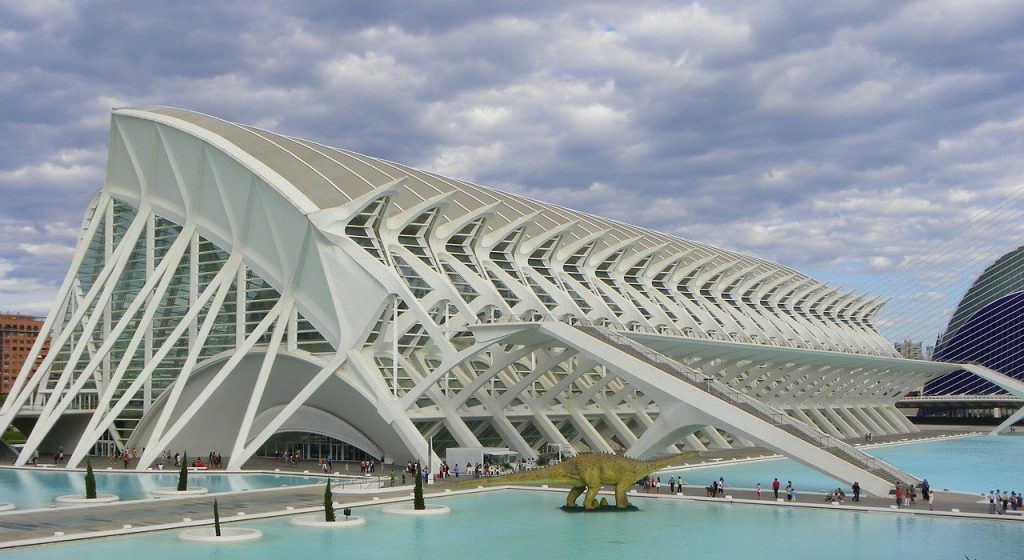
The Museum of Science is a spectacular building that houses interactive scientific motifs and exhibitions in which visitors can touch everything and become the protagonists of curious experiments. It is an amazing museum of the 21st century, which shows in an interactive, didactic and entertaining way everything related to the development and evolution of life, science and technology.
There are several interactive exhibits and a variety of scientific animations that introduce us to new technologies and the great advances in science. The variety of interactive exhibits and the numerous outreach activities that take place at the Museum have been a great success with the public. The public has undoubtedly responded vigorously to the proposal to transmit and disseminate technology and science through fun and entertainment, while at the same time without renouncing the minimum scientific rigour that is essential when dealing with the subjects to be dealt with.
In all communication activities, live experimentation with the environment provided continues to be the best, most stimulating and fun way of obtaining scientific knowledge. For this reason, in addition to the exhibitions, the Museum offers a very complete programme of scientific activities, which helps to encourage the participation of the public and their help with the monitors.
Oceanographic
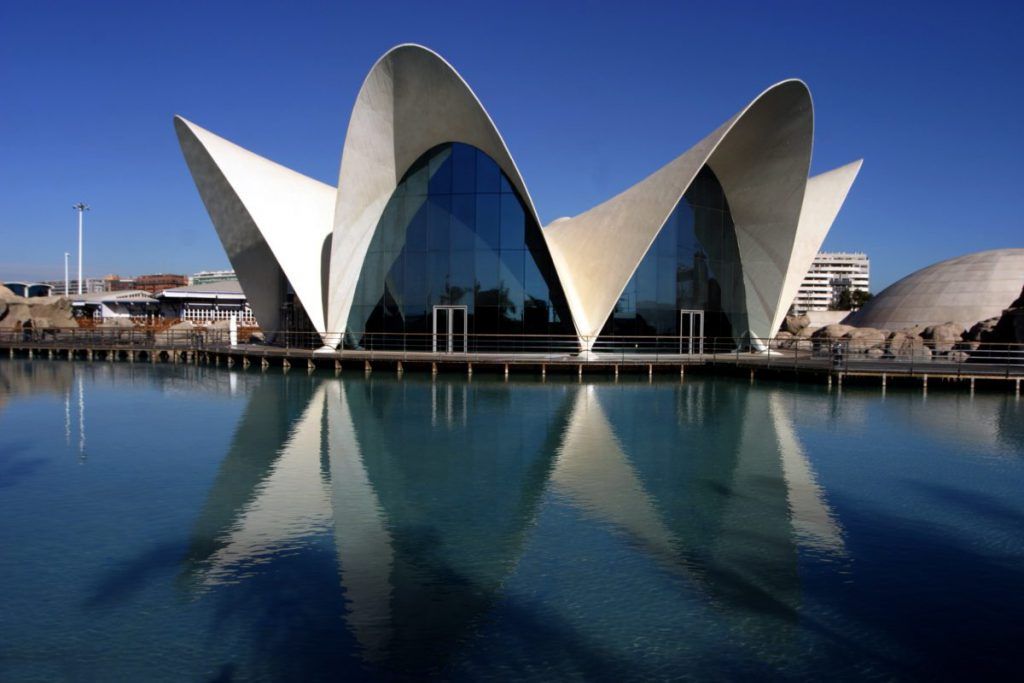
With over 45,000 specimens and more than five hundred species, the Oceanogràfic is the largest aquarium in Europe. It is a true tribute to the planet’s seas and oceans. It is made up of several buildings that house examples of the most important ecosystems of the planet’s seas and oceans: Wetlands, Temperate and Tropical, Oceans, Arctic, Antarctic and Islands; including the Red Sea, which is represented in the aquarium of the Underwater Auditorium and the Dolphinarium, considered the most important in Europe.
The Oceanographic opened to the public on 14 February 2003, and today it is the largest marine complex in Europe, suggesting a journey through all the seas and oceans of the planet, transporting visitors to the most exceptional marine ecosystems. Its innovative architecture, the distribution of the different aquariums and its recreational, scientific and educational vocation bring the marine world closer to the population and try to raise awareness about the protection of its flora and fauna, also serving as a base for scientific research.
It has a surface area of 110,000 square metres.
It is one of the largest dolphinariums in the world, containing 26 million cubic metres of water with a depth of 10.5 metres.
It has 6,761 square metres of methacrylate panels up to 33 centimetres thick.
It has 150,000 cubic metres of concrete plus 15,000 tonnes of steel.
It also has more than 25 kilometres of pipes with diameters ranging from 1.4 centimetres to 1.3 metres.
It is a large igloo-shaped dome that houses the Arctic zone. A large sphere 26 metres high that simulates two of the most unique wetland environments on the planet: the American mangrove swamp and the Mediterranean marsh. The underwater restaurant is located in the centre of the enclosure and is the most emblematic building of the Oceanogràfic, thanks to the peculiarity of its roof. The roofs of the Access Building were designed to evoke a paraboloid figure similar to a water lily. The exhibition of a large aquarium on the ground floor makes the building even more unique.
Hemisferic
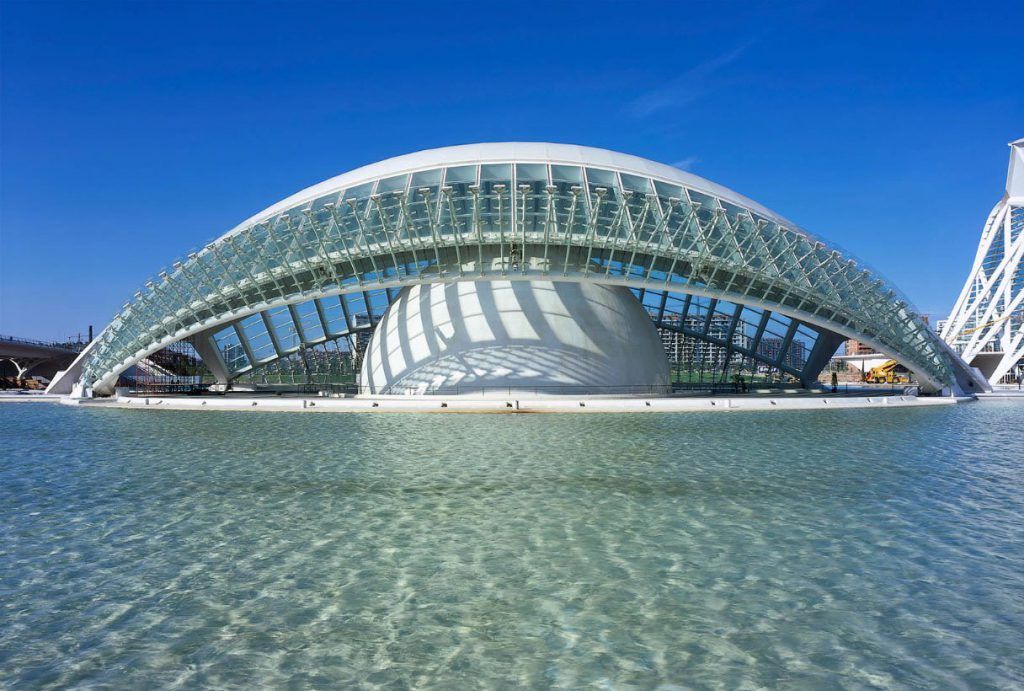
The Hemisfèric offers us state-of-the-art Imax cinema films, an innovative laser show and a planetarium. The Hemisférico (in Spanish) was the first of the buildings to open to the public on 10 April 1998, belonging to the City of Arts and Sciences of Valencia in Spain.
The building designed by Santiago Calatrava is an analogy of an eye, which inside houses a huge hall with a concave screen of 900 m² and 24.4 m in diameter, where its programming covers science and technology themes and changes periodically. It has an approximate surface area of 143,000 m², serving 2 projection systems
Digital projections with entertainment shows as well as astronomical performances.
Cinema in IMAX Dome format.
The Hemispheric was the first building of the City of Arts and Sciences to open its doors to the public in 1998 with its inauguration. It is a spectacular building designed by Santiago Calatrava and has an ovoid roof more than 100 metres long, which houses the sphere that makes up the projection room.
9. Reina Sofía Palace of the Arts
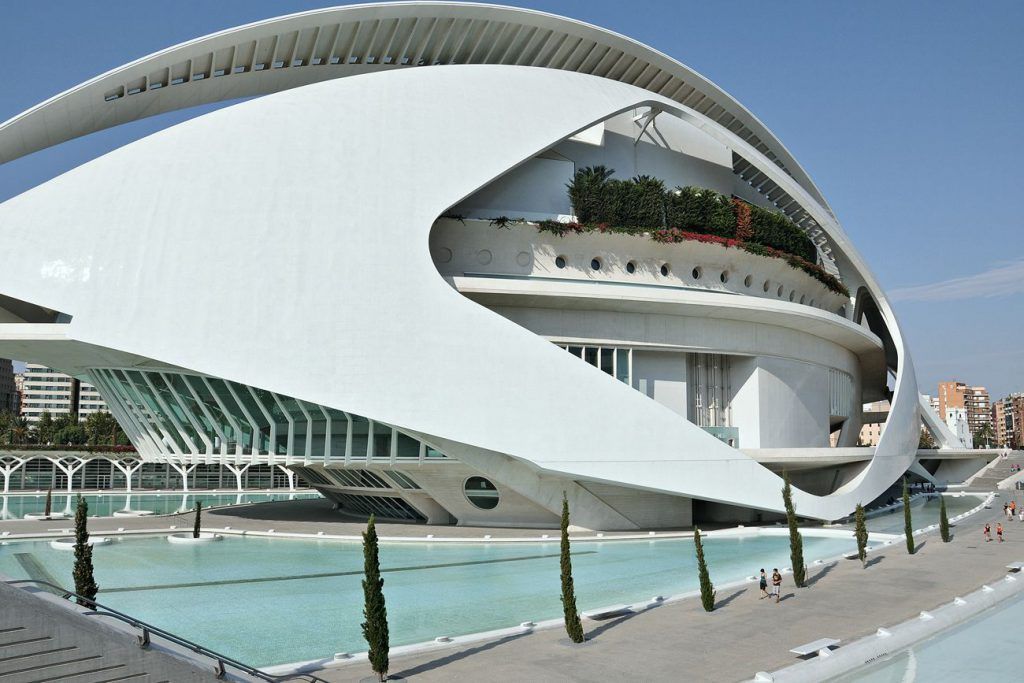
The Reina Sofía Palace of the Arts, after the inauguration of the Hemisfèric in 1998, the Science Museum together with the Umbracle in 2000 and the opening of the Oceanogràfic to the general public in 2003 complete the artistic ensemble that represents this valuable commitment of the Generalitat to culture in its broadest sense. Together with technology, science and nature.
It was inaugurated in 2005 and has the most modern technology, adapting to the image that corresponds to a modern, avant-garde space. It has also become a cultural dynamizer, placing the Valencian Community, from its centenary musical tradition, in a great and privileged place worldwide.
The imposing building was designed by the Valencian engineer and architect Santiago Calatrava, guaranteeing the city of Valencia and the Valencian Community the best infrastructure to put them on the international circuits, especially in terms of opera and great musical shows.
10. La Albufera, one of the essential places to see in Valencia
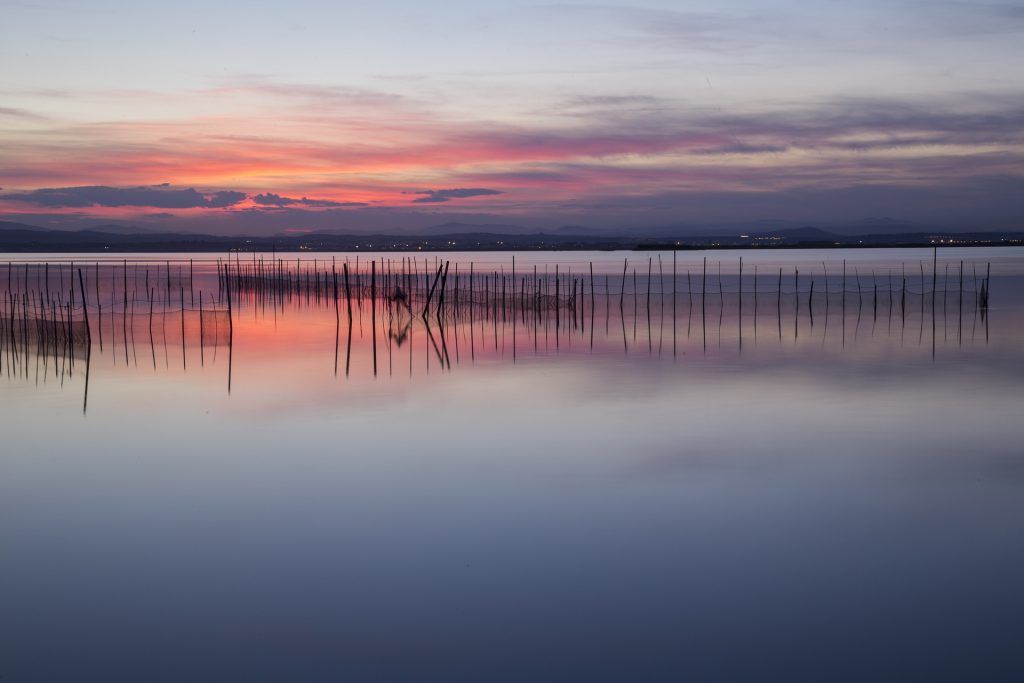
The Albufera Natural Park is only 10 km from the city. It offers nature in its purest state, dreamlike sunsets, boat trips and total disconnection. Like an urban paradise surrounded by forest and rice fields: this is the Albufera Natural Park, the place where paella was invented.
Pure natural surroundings, spectacular sunsets, boat trips and disconnection from the real world with direct transport to relaxation and fun. Like an urban paradise surrounded by rice fields and forest: this is what the Albufera Natural Park is like for all those who know it. Moreover, you have to visit it to understand the origin of Valencian gastronomy. It is precisely here that paella was invented. So you can’t leave Valencia without visiting La Albuera and having a paella, the best in Spain.
What to see in the Albufera of Valencia?
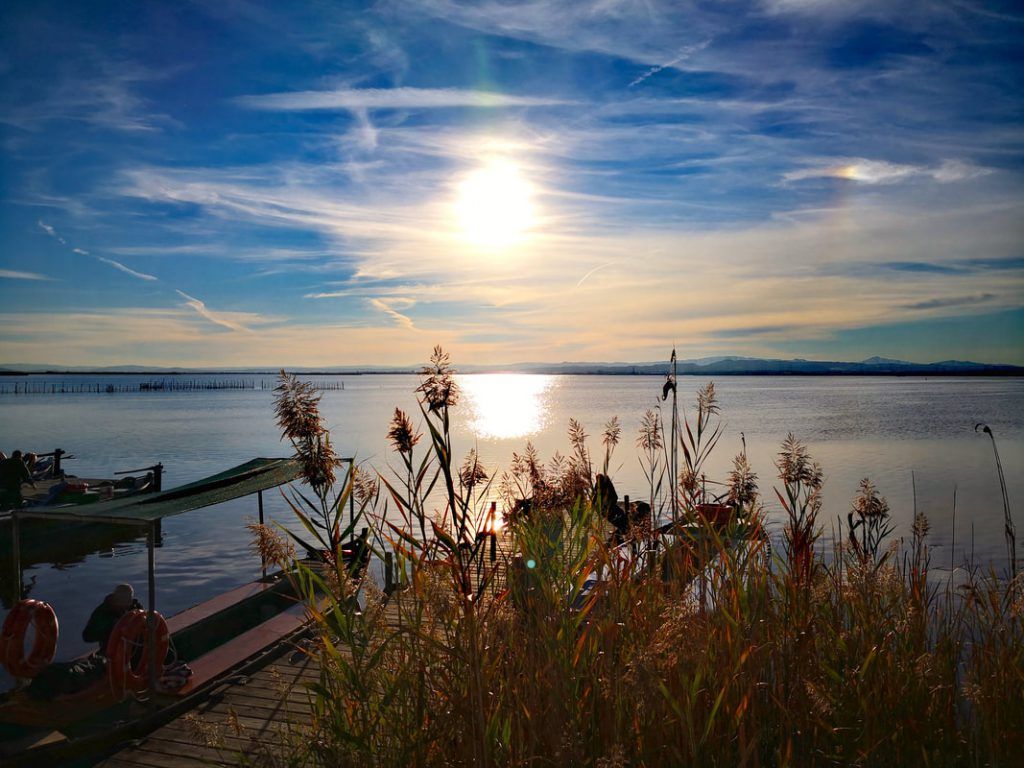
In El Palmar you can taste a wide variety of typical dishes such as all-i-pebre or llisa adobada and savour a new way of understanding food while enjoying and learning about its origins. Take a stroll through any of the six signposted sites in this natural park. Inside the park you can experience and discover a new space worthy of getting to know and enjoying to the full.
To get to the Albufera in less than an hour and for €1.50, you can easily get there on line 25 of the EMT city buses. This line runs from the centre of Valencia to El Palmar and El Perellonet. You can get off at the pier and enjoy a ride in a traditional boat on the lake. There is also the Albufera Bus Turistic with which you can enjoy a complete view of the Albufera Natural Park, discovering the ecosystems of the rice fields and a boat ride.
How to get to Valencia?
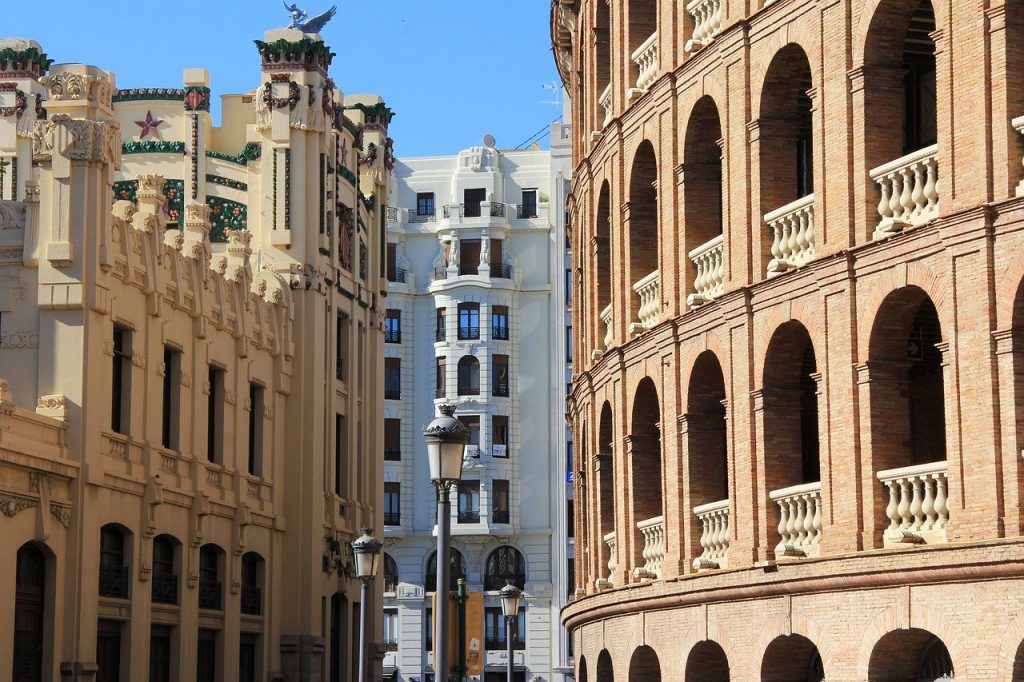
There are different ways to get to Valencia, by air, land and sea. The city is connected to the main European and Spanish cities. Valencia airport is just 8 kilometres from the city, and offers regular daily flights to the most important national and international destinations. It is one of the best ways to reach the capital of the Valencian Community.
Valencia also has two train stations: the Joaquín Sorolla high-speed train station, from where AVE trains depart to Madrid, Seville, Cordoba and Cuenca. The Sorolla station is also the departure point for Euromed and Alvia long-distance trains, which connect Valencia with Barcelona and other cities. The other station is the Estación del Norte or Valencia Nord, and it is here that the local train network operates.
The port of Valencia city is one of the most important in the Mediterranean Sea in terms of trade traffic. The port connects Valencia by ship with Italy and the Balearic Islands. The city is increasingly becoming a popular destination for cruise ships which dock at the western quay, in order to be able to explore the city for a few hours.
If you want to reach the city of Valencia by car, there is no need to worry, as Valencia is connected to the main Spanish cities by means of a modern road network, the most important of which are the AP-7, which runs from north to south along the entire Levantine coast and links Valencia with Barcelona and Alicante, and the A-3, which runs towards the centre of the peninsula towards Madrid.
Valencia can be reached by plane, by train, by car or by boat on a cruise ship. Either way, getting there is very easy. Valencia is a city well worth visiting, as the number of people who visit year after year speaks for itself.
Map with essential places to see in Valencia
Find the essential places to visit on this map of Valencia so that you can make a route to suit you for the days you spend in the city. If you don’t have time to include all the monuments and buildings, don’t get overwhelmed. It’s good to have reasons to come back to a city as beautiful as this one.
These recommendations with the most emblematic places are only suggestions on what to see and visit in Valencia. There may be other places of interest that are also worth visiting outside of this selection, but they are entirely complementary – the important thing is that you enjoy yourself and soak up the local culture!
Leave a Reply